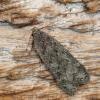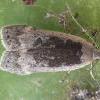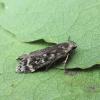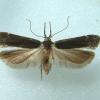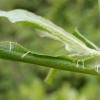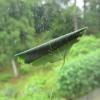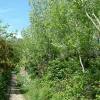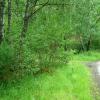35.011 Anacampsis populella (Clerck, 1759)
Status and Distribution
Local to locally common over much of England as far north as Cheshire and Lancashire and Wales. Very local in south Cumbria, north Yorkshire and southern Northumberland. Apparently absent from large parts of northern England and southern Scotland with the exception of a few historic records in Ireland and two twentieth century records from the Glasgow area. It is then found locally over much of the Highlands of Scotland with larval records suggesting it is mainly (perhaps exclusively?) associated with Aspen in the Highlands.
Until 1947, A. blattariella was not recognised as a separate species in Britain, having been split from A. populella a few years previously on the continent. Documented records of non-bred A. populella prior to this period could refer to either species unless subsequently dissected.

Provisional map
Set Specimens
Foodplant and Larval Feeding Signs
Populus alba (white poplar), see plant distribution map; also on Populus alba x tremula (grey poplar), Populus nigra (black poplar and lombardy poplar), Populus tremula (aspen), Salix caprea (goat willow), Salix cinerea (grey willow), Salix fragilis (crack willow), Salix repens (creeping willow) and Salix viminalis (osier).
Spins a leaf into a tube, by rolling the leaf, which remains fresh and has silken strands showing on the edges of the rolls. The spinning on Salix repens differs due to the small size of the leaves. Here the larva spins several leaves rond the central stem, starting a short distance down from the shoot tip.
Gypsonoma dealbana has, on one occasion, been bred from one of two rolled leaves on Populus canescens (G. Tordoff pers. comm.). The other roll produced Anacampsis populella and although one roll was more on the leaf edge and slightly smaller than the other (and it was not known from which G. dealbana emerged), they were rather similar. A note on how to separate the larvae of these two species can be found in the 'Finding' section.
Habitat
Finding the Moth
Larva: feeds from mid-April to June in rolled leaves of the foodplant (in Scotland, on aspen, from late May to the end of July), pupating in the rolled leaf. Gypsonoma dealbana has on one occasion been bred from a rather similar but possibly smaller roll than that made by A. populella. The larva of G. dealbana is rather similar to some instars of A. populella but lacks the prominent black pinacula of that species.
Adult: can be dislodged from trees, found resting on tree trunks, swept from creeping willow and later comes readily to light.
Similar Species
Both Anacampsis blattariella and A. populella are variable species with overlap in the forewing markings and colour, particularly in the extent of blackish markings. A transverse pale fascia at three-quarters (if visible) often has a strong zig-zag style in the costal half in A. blattariella (more curved in A. populella) but there is variation in this. Information received from some County Moth Recorders and other experienced moth recorders suggest those moths at the extremes (dull greyish fuscous or strongly black and white) are often identifiable from the forewing markings alone but the many intermediates and those which have become worn will not be identifiable without dissection, unless bred. Their comments are based on experience of the habitat and moths in their areas where both breeding and dissection have been carried allowing familiarity with the 'look' of their local moths to be applied. It is therefore suggested any caught specimens are retained for potential dissection (see more below).
Although adults found resting on the trunks of willows, poplars and aspen are likely to be A. populella, care should be taken as moths do wander and alder (an additional foodplant of A. blattariella) can be found where willow species occur.
The best way to become familiar with this pair at a site is to breed them through from known foodplants whilst also retaining a few trap-caught specimens for dissection. This will demonstrate if both species are present and develop familiarity with the range of markings present in your locality.
Examination of the photographs on this and other websites which specifically show dissected or bred specimens of both species is strongly recommended, as these illustrate some of the pitfalls in their identification. It is advisable to adopt a very cautious approach if attempting to either identify or use as a guide, specimens from websites or on-line postings where the specimens have not been critically examined or bred.
A. blattariella was first recorded in Britain in 1947 so documented records of non-bred A. populella prior to this period may well include records of A. blattariella.
To further complicate matters, it is mentioned in Emmet and Langmaid, 2002 The Moths of Great Britain and Ireland Vol. 4 (2), that although these two closely related species are considered to be clearly separated on the continent, the separation may not be so complete in Britain. 'Specimens reared by D A B Macnicol from larvae in rolled Betula leaves from Surrey in 1952 are large, weakly marked and have female genitalia approximating more to A. populella than to A. blattariella.'
Single brooded from late June to mid-September (mid-July to late September in Scotland).


